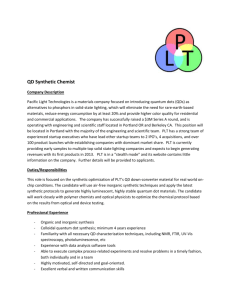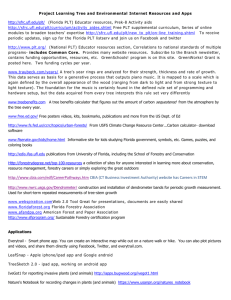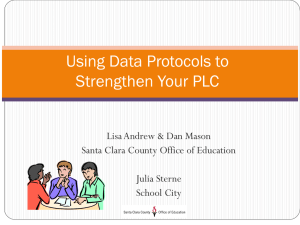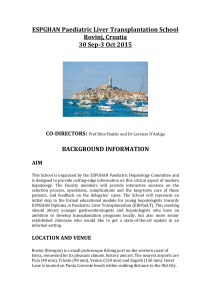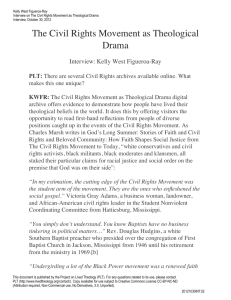Eighth Grade
advertisement
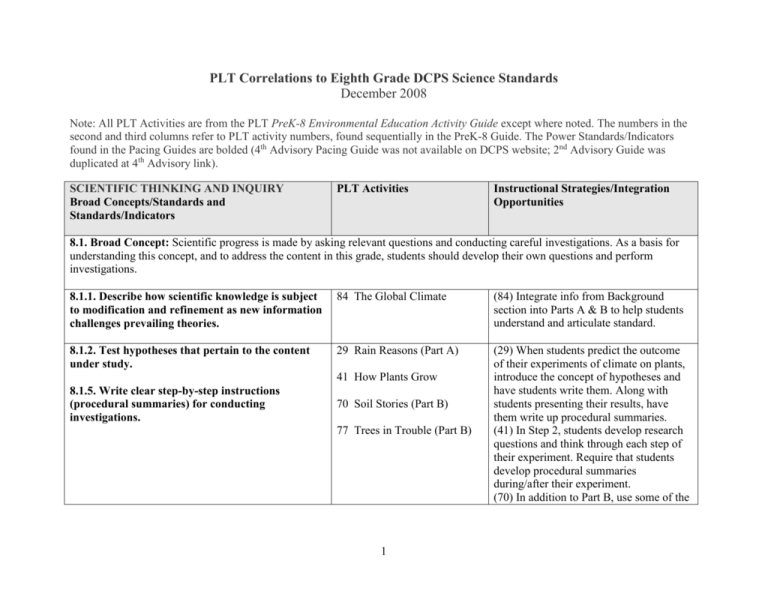
PLT Correlations to Eighth Grade DCPS Science Standards December 2008 Note: All PLT Activities are from the PLT PreK-8 Environmental Education Activity Guide except where noted. The numbers in the second and third columns refer to PLT activity numbers, found sequentially in the PreK-8 Guide. The Power Standards/Indicators found in the Pacing Guides are bolded (4th Advisory Pacing Guide was not available on DCPS website; 2nd Advisory Guide was duplicated at 4th Advisory link). SCIENTIFIC THINKING AND INQUIRY Broad Concepts/Standards and Standards/Indicators PLT Activities Instructional Strategies/Integration Opportunities 8.1. Broad Concept: Scientific progress is made by asking relevant questions and conducting careful investigations. As a basis for understanding this concept, and to address the content in this grade, students should develop their own questions and perform investigations. 8.1.1. Describe how scientific knowledge is subject to modification and refinement as new information challenges prevailing theories. 84 The Global Climate (84) Integrate info from Background section into Parts A & B to help students understand and articulate standard. 8.1.2. Test hypotheses that pertain to the content under study. 29 Rain Reasons (Part A) (29) When students predict the outcome of their experiments of climate on plants, introduce the concept of hypotheses and have students write them. Along with students presenting their results, have them write up procedural summaries. (41) In Step 2, students develop research questions and think through each step of their experiment. Require that students develop procedural summaries during/after their experiment. (70) In addition to Part B, use some of the 41 How Plants Grow 8.1.5. Write clear step-by-step instructions (procedural summaries) for conducting investigations. 70 Soil Stories (Part B) 77 Trees in Trouble (Part B) 1 Enrichment opportunities listed for more student-led experiments. Have students develop hypotheses and write up a report, including step-by-step methods. (77) One Assessment Opportunity involves students writing detailed report on one of the experiments. Checklist for assessing reports, including proper format for hypotheses and procedure, is provided. 8.1.3. Describe how if more than one variable changes at the same time in an experiment, the outcome of the experiment may not be attributable to a change in any single variable. 29 Rain Reasons (Part A) 41 How Plants Grow 77 Trees in Trouble (Part B) 84 The Global Climate (Part B) (29, 41, 77) Steps in each experiment explain to students to only change the one variable and keep all other conditions the same. Explain to students at these steps that this is necessary because if more than one variable changes then any changes in the outcome can’t be linked to any one variable. (84) Use Part B to focus on the content of this standard. The Climate Study changed one variable— temperature. Ask students why the scientists only changed the one variable. 8.1.4. Explain why accuracy and openness in record keeping and replication are essential for maintaining an investigator’s credibility with other scientists and society. 29 Rain Reasons (Part A) 41 How Plants Grow 70 Soil Stories (Part B) 71 Watch on Wetlands (Part A) 2 Easy to integrate standard into all activities while students recording data and/or writing up reports (except 84). Ask students why it is important that scientists be accurate and open with their findings (because of credibility of scientist; impact of findings on society; etc.) 77 Trees in Trouble (Part B) 84 The Global Climate 8.1.6. Participate in group discussions on scientific topics by restating or summarizing accurately what others have said, asking for clarification or elaboration, and expressing alternative positions. (84) Use topic of this activity and Background information provided to discuss that there has been some discrepancy in the past among scientists regarding climate change. Depending on the level of your students, you may choose to have them conduct research on the topic and give ideas as to why some scientists have disagreed with the majority (more so a few years ago as opposed to today). Ask what impact it might have on scientists when they are not accurate or open with data. 33 Forest Consequences 50 400-Acre Wood 84 The Global Climate 8.1.7. Use tables, charts, and graphs in making arguments and claims in presentations about lab work. 29 Rain Reasons (Part A) 8.1.8. Read analog and digital meters on instruments used to make direct measurements of length, volume, weight, elapsed time, rates, or temperatures, and choose appropriate units. Explain how to interpolate on analog scales. 70 Soil Stories (Part B) 41 How Plants Grow (29) In step 5, have students first graph their results or compile them in a table/chart before presenting them to the class. 71 Watch on Wetlands (Part A) 77 Trees in Trouble (Part B) 8.1.9. Explain why arguments may be invalid if based on very small samples of data, biased 41 How Plants Grow 3 Control samples are included in both activities. Discuss with students why samples, or experiments in which there was no control sample. 77 Trees in Trouble (Part B) 8.1.10. Identify and criticize the reasoning in arguments in which fact and opinion are intermingled or the conclusions do not follow logically from the evidence given, an analogy is not apt, no mention is made of whether the control group is very much like the experimental group, or all members of a group are implied to have nearly identical characteristics that differ from those of other groups. N/A 8.1.11. Describe the work of pioneers of physics and cosmology, such as Nicolaus Copernicus, Galileo Galilei, Johannes Kepler, Isaac Newton, Hans Christian Oersted and Andre-Marie Ampère, Dmitry Ivanovich Mendeleyev, Albert Einstein, and Lise Meitner. 12. Apply simple mathematical models to problems (e.g., formulas such as F = ma). 4 small samples or biased samples might make arguments invalid, just like if no control was present. Use a simple example first (e.g., an argument that all children like cake best for dessert when only one class in a school served as the sample). STRUCTURE OF MATTER Broad Concepts/Standards and Standards/Indicators PLT Activities Instructional Strategies/Integration Opportunities 8.2. Broad Concept: Elements have distinct macroscopic properties and atomic structures. 8.2.1. – 8.2.10. N/A REACTIONS Broad Concepts/Standards and Standards/Indicators PLT Activities Instructional Strategies/Integration Opportunities 8.3. Broad Concept: Chemical reactions are processes in which atoms are rearranged into different combinations of molecules. 8.3.1. – 8.3.7. N/A DENSITY AND BUOYANCY Broad Concepts/Standards and Standards/Indicators PLT Activities 8.4. Broad Concept: All objects experience a buoyant force when immersed in a fluid. 8.4.1. – 8.4.5 N/A 5 Instructional Strategies/Integration Opportunities CONSERVATION OF ENERGY Broad Concepts/Standards and Standards/Indicators PLT Activities Instructional Strategies/Integration Opportunities 8.5. Broad Concept: Energy and matter have multiple forms and can be changed from one form to another. 8.5.1. Explain how energy is the ability to do work and PLT’s Energy & Society Kit: is measured in joules (J). Student Energy Primer 1 Energy Detectives 3 Energy Chains 6 Energy Challenge 8.5.2. Describe kinetic energy as the energy of motion (e.g., a rolling ball), and potential energy as the energy of position or configuration (e.g., a raised object or a compressed spring). For specific info on joules, see p. 13 of Background Information for Educators and definition of “energy” in Glossary. PLT’s Energy & Society Kit: 1 Energy Detectives 3 Energy Chains 6 Energy Challenge 8.5.3. Investigate and explain how kinetic energy can be transformed into potential energy, and vice versa (e.g., in a bouncing ball). 8.5.4. Recognize and describe that energy is a property of many systems and can take the forms of mechanical motion, gravitational energy, the energy of electrostatic and magnetostatic fields, sound, heat, and light (electromagnetic field energy). 8.5.5. Describe that energy may be stored as potential energy in many ways, including chemical bonds and in the nucleus of atoms. 39 Energy Sleuths (Parts B & C) PLT’s Energy & Society Kit: 1 Energy Detectives 6 (39) Energy Primer student pages describe different nonrenewable and renewable energy sources. Included is Uranium (Nuclear Energy) where an atom’s nucleus is split apart to release energy. 2 May the Source Be with You 3 Energy Chains 6 Energy Challenge 8.5.6. Explain that the sun emits energy in the form of light and other radiation, and only a tiny fraction of that energy is intercepted by the Earth. 39 Energy Sleuths (Parts B & C) PLT’s Energy & Society Kit: 1 Energy Detectives 2 May the Source Be with You 3 Energy Chains 6 Energy Challenge 8.5.7. Know that the sun’s radiation consists of a wide range of wavelengths, mainly visible light, infrared, and ultraviolet radiation. N/A 8.5.8. Investigate and explain that heat energy is a common product of an energy transformation, such as in biological growth, the operation of machines, the operation of a lightbulb, and the motion of people. PLT’s Energy & Society Kit: 1 Energy Detectives 3 Energy Chains 8.5.9. Explain how electrical energy can be generated using a variety of energy sources and can be transformed into almost any other form of energy, such as mechanical motion, light, sound, or heat. PLT’s Energy & Society Kit: 1 Energy Detectives 2 May the Source Be with You 3 Energy Chains 6 Energy Challenge 8.5.10. Investigate and explain that in processes at the scale of atomic size or greater, energy cannot be created or destroyed but only changed from one form into another. PLT’s Energy & Society Kit: 3 Energy Chains 7 See also p. 10 of PLT’s Energy & Society Activity Guide. 8.5.11. Compare and contrast how heat energy can be transferred through radiation, convection, or conduction. N/A ELECTRICITY AND MAGNETISM Broad Concepts/Standards and Standards/Indicators PLT Activities Instructional Strategies/Integration Opportunities 8.6. Broad Concept: Electricity and magnetism are related phenomena that have many useful applications in everyday life. 8.6.1. – 8.6.5. N/A FORCES Broad Concepts/Standards and Standards/Indicators PLT Activities Instructional Strategies/Integration Opportunities 8.7. Broad Concept: When an object is subject to two or more forces at once, the effective force is the cumulative effect of all the forces. 8.7.1. – 8.7.7. N/A 8 WAVES Broad Concepts/Standards and Standards/Indicators PLT Activities Instructional Strategies/Integration Opportunities 8.8. Broad Concept: Waves have characteristic properties that are common to all types of wave. 8.8.1. – 8.8.9. N/A 9

